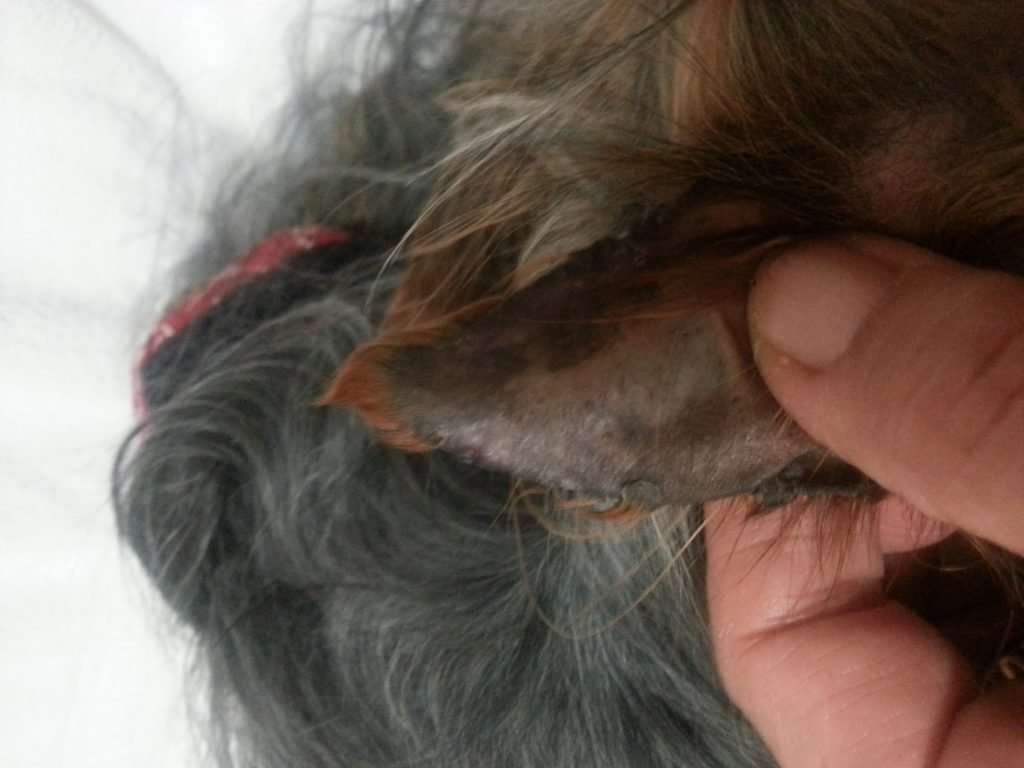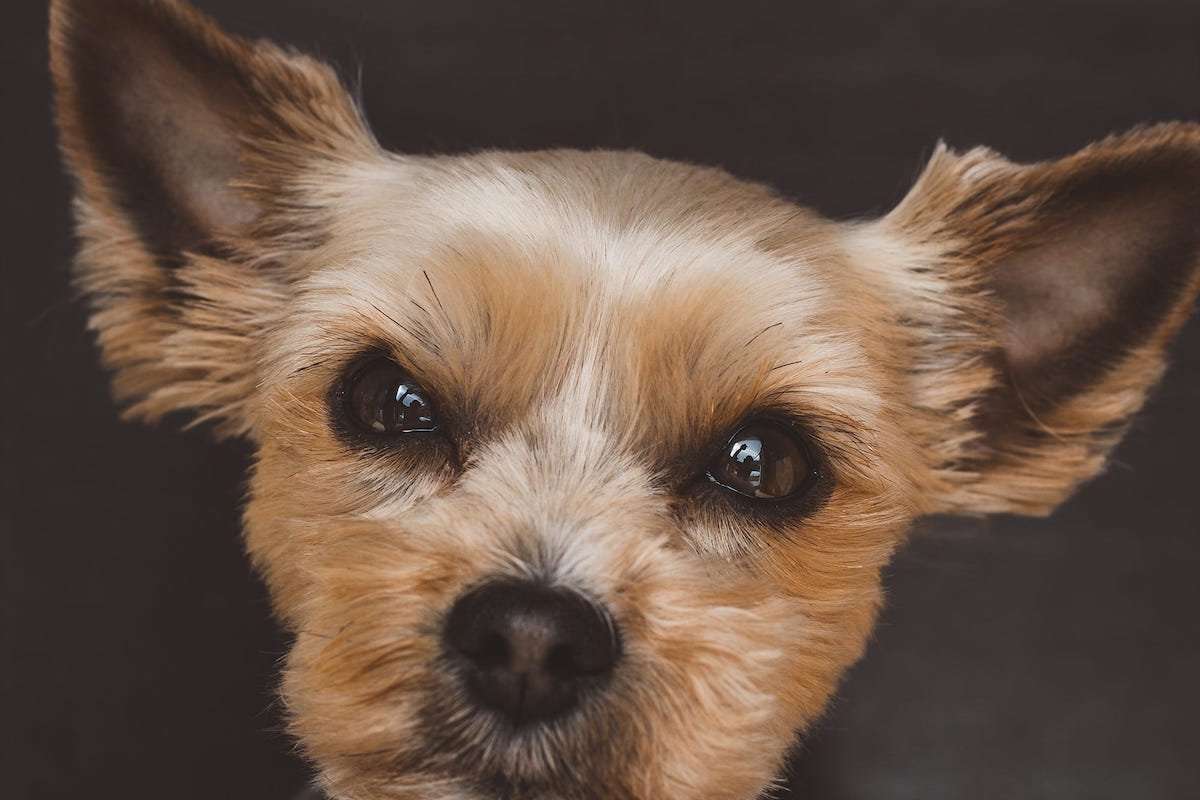This content is for informational purposes only, not veterinary advice. You should consult your vet before making any decisions about treatments for your pet. The Dog Tale is reader-supported. We may earn a commission if you buy something through our site; this doesn’t change our recommendations.
If you have a Yorkie or other dog breed that has started forming dark bald spots on their ears, behind, or tail, you may be dealing with leather ear. Not much is understood about the issue, but, fortunately, there are some treatments that may help. Keep reading to learn more.
In this guide:
- Protect your pet in seconds
- Accident & Illness + Optional Wellness coverage available
- Policies start at just $9.99/mo
What is leather ear?
Leather ear is the phenomenon of a dog’s ears losing their hair before taking on a dark, leathery appearance and sometimes a slimy texture. It’s also been called winter ear, English ear, slick ear, and black ear.
The ailment is believed to be more common during the winter months (hence the name “winter ear”), and some pet owners have reported that the infection has spread to other parts of their dog’s body, such as the legs, tail, and behind, forming bald patches of hyper-pigmented skin.
It’s not clear what exactly causes leather ear.

Does leather ear only affect Yorkies?
No. Yorkshire Terriers seem to be the most common breed affected by leather ear, causing some to name the ailment “Yorkie leather ear.” However, leather ear has been known to affect other dog breeds.
Dogs with silky coats, such as most Yorkies, tend to suffer from leather ear more often than dogs with cotton coats.
How to treat leather ear in Yorkies
The causes and exact treatments for leather ear are not well established, so it may take some experimentation to find a remedy for your dog. However, there is anecdotal evidence from dog owners that the treatments below may help.
1. Talk to a vet to rule out other issues
As with most dog health issues, we recommend consulting a veterinarian. You’ll want to rule out other major Yorkie health issues, such as Alopecia X or thyroid issues, which can also lead to hair loss.
Other ear problems, such as Yorkie ear mites, could also be the culprit and may require different treatment.
- Unlimited consultations by video/text
- $3,000/year emergency fund + Rx discounts
- Cover up to 6 pets for just $24/month
- Try it FREE for 7 days
2. Try one these topical treatments (or a combination of them)
If your vet approves, these topical treatments have reportedly helped other dogs with leather ear. As with any treatment, we suggest you closely monitor your dog’s body and behavior for signs of an adverse reaction.
Lotrimin 1% Antifungal Cream
The most common and effective solution reported is to apply Lotrimin 1% Antifungal Cream to the affected areas once a day until the infection shows signs of improvement. Lotrimin is an over-the-counter anti-fungal product that comes in cream, powder, and spray forms.
However, note that in some forms, the active ingredient comes in concentrations higher than 1%. You want a concentration of just 1%, and the cream may be the easiest form for treating only the infected areas.
You may want to try to de-scab or rub clean the affected areas with one of the solutions below before applying the cream.
50-50 ACV/water solution
A second solution some pet owners report is to apply a mixture of equal parts apple cider vinegar and water to the ears once or twice a day. Dip a cotton ball in the mixture and gently rub the ears in a circular motion, both to cover the infected areas and to try to wipe away any loose black specks.
Make sure you don’t allow any moisture to drip down into your dog’s ears, or your Yorkie may develop additional ear infection.
50-50 hydrogen peroxide/water solution
Another solution reported is to use hydrogen peroxide instead of apple cider vinegar in the mixture above. The treatment method would remain the same.
Ear wipes
If you don’t like the idea of applying hydrogen peroxide or apple cider vinegar to your dog’s ears, ear wipes, such as Pet MD Ear Wipes for Dogs, are an easy way to keep your pup’s ears clean.
These wipes likely won’t cure leather ear on their own, but if used before applying a dose of Lotrimin, they could help clear the infection more quickly—and ward off other fungal infections from forming. Just rub the affected area and look for little black specks that come free.
After you’re rid of the infection, keep using the wipes once or twice a month to clean out your Yorkie’s ears.
What about tea tree oil?
Some dog owners have reported having luck with tea tree oil. This makes sense since tea tree oil is known to have antifungal properties.
However, what’s not known to most people is that tea tree oil is toxic to both animals and humans when ingested in high proportions. Unless diluted to a proportion of just .1%–1%, you could endanger your pet, and it’s easy to mess up that calculation on your own.
Instead, we recommend using a pet-safe antiseptic spray if you want to sterilize a wound or infected area on your dog’s skin.
How to Fix Yorkie Dry Skin, Itching, Bumps, & Other Conditions
Let's bark a little
Get our latest updates and articles right in your email.
We won't bark too much. Promise.
Lemonade Pet Insurance Review: Is it Good?
Wagmo Pet Insurance Review: Wellness Plans & Coverage for Accidents



